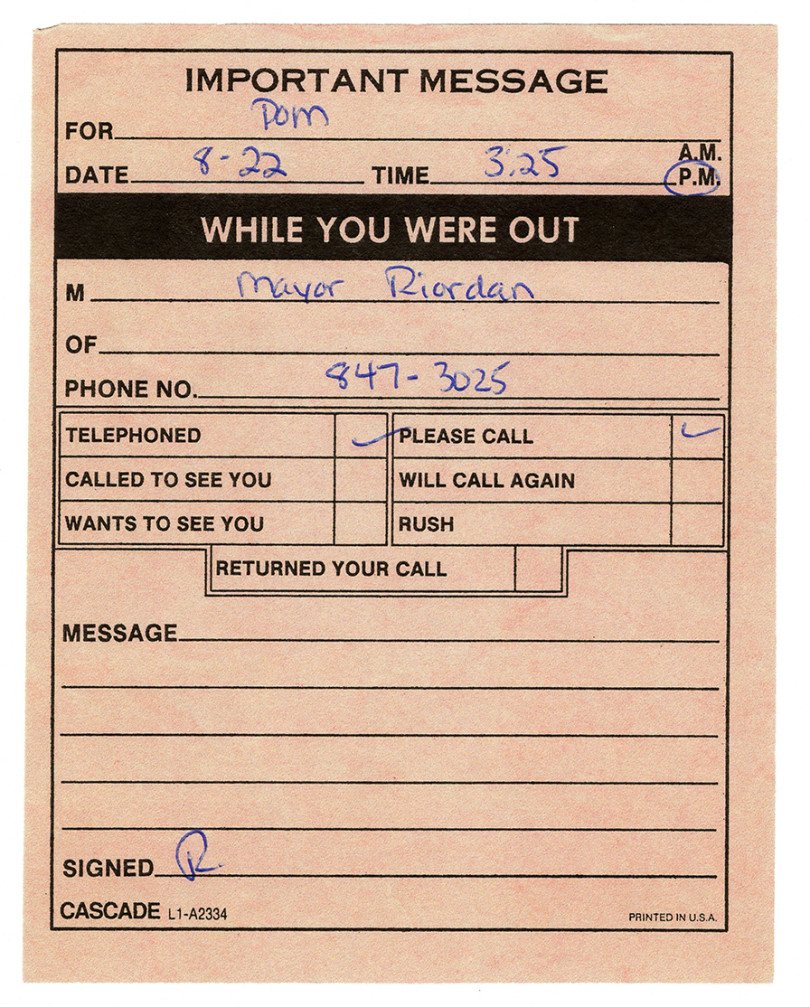
August 22, 1995, 3:25 p.m. telephone message slip informing Peter O'Malley that Los Angeles Mayor Richard Riordan had called. When Peter returned the Mayor’s call, Riordan asked him two questions: 1) Do the Dodgers have room to accommodate a new stadium for an NFL team, and 2) If so, do you have an interest in doing so?
Feature
Football and Peter O’Malley
By Brent Shyer
The Dodgers were in the midst of a very exciting 1995 season and “Nomomania” was in full swing. Following a prolonged players’ strike that shut down Major League Baseball and its 1994 postseason and delayed the start of the 1995 season, baseball was making its comeback, thanks in large part to savior Hideo Nomo, the first Japan-born player to participate in MLB in 30 years.
Dodger President Peter O’Malley was thrilled with Nomo’s first season success, the reaction of Dodger fans as they supported and followed his every move, the country of Japan’s overwhelming enthusiasm for Nomo, and the team’s first place record in the National League West. Nomo was well on his way to winning the National League Rookie of the Year award and was given the rare opportunity to start as a rookie for the N.L. in the All-Star Game after going 6-0 in June.
O’Malley’s professional career and life were about to change on August 22, 1995.
The NFL’s Rams and Raiders had left a void in Los Angeles following the 1994 season. The Rams had moved to St. Louis, while the Raiders returned to Oakland. Los Angeles Mayor Richard Riordan called Peter O’Malley’s office on August 22. O’Malley was out of the office, but received a pink message slip at 3:25 p.m. to call Riordan. O’Malley returned Riordan’s call and the Mayor asked two questions, “Do you have room to accommodate a new stadium for an NFL team? and, do you have an interest?” Riordan explained to O’Malley that “We have a football problem.” O’Malley recalled, “I was sitting in my office, minding my own damn business, when the mayor called and told me I could be a big help.” Diane K. Shah, Los Angeles magazine, November, 1998
That call began a nearly two-year quest to fulfill the mayor’s request, O’Malley telling the mayor, “We’ll take a good faith look at it.” Jon Regardie, Los Angeles independent Newspaper Group, January 31, 1996
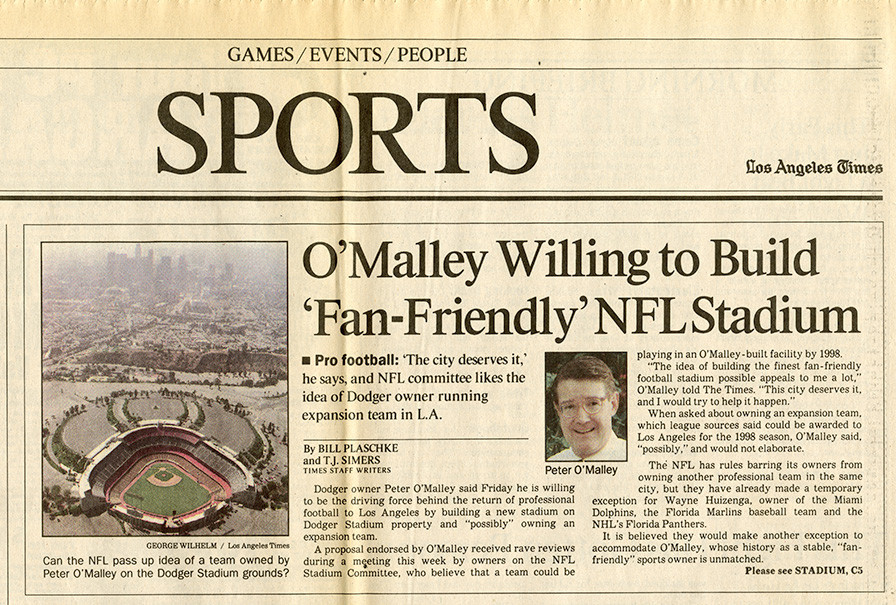
September 9, 1995 sports page of the Los Angeles Times with the top story about the interest of Peter O’Malley to privately build a “fan-friendly” NFL stadium to attract a team for the city of Los Angeles.
On September 23 O’Malley said: “Los Angeles needs and deserves to have a state-of-the-art, fan-friendly football stadium, and participating in a project like that appeals to me very much. We will work to ensure that the needs of the fans, the community-at-large, and the surrounding neighborhoods are considered and addressed in the process.” Associated Press, September 23, 1995 O’Malley said, “I’m not interested in building another football stadium; my keen interest is in building the finest football stadium in the world. The city deserves that, the citizens deserve that, and that is the only basis in which I am interested.” T.J. Simers, Los Angeles Times, December 3, 1995
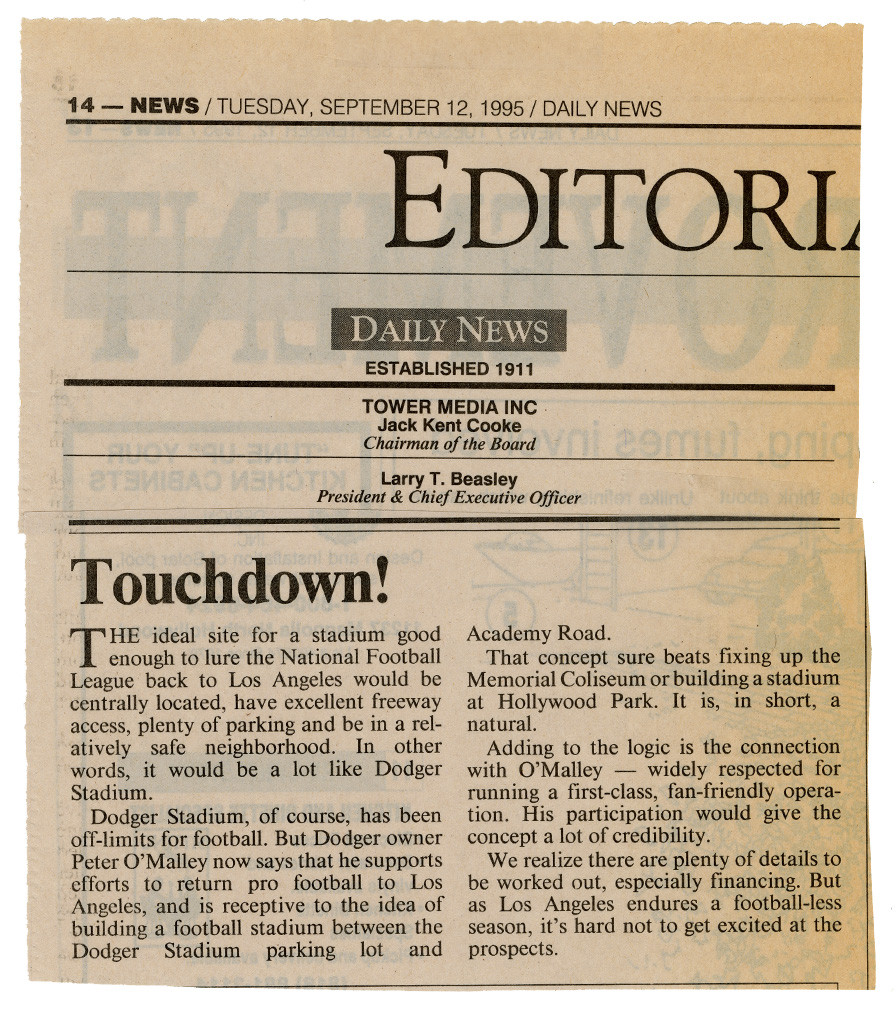
September 12, 1995 editorial in the Los Angeles Daily News about Peter O’Malley and his interest in privately building a stadium to attract an NFL team back to Los Angeles under the heading “Touchdown!”. The editorial reports, “Adding to the logic is the connection with O’Malley – widely respected for running a first-class, fan-friendly operation.”
Bob Keisser of the Long Beach Press-Telegram wrote, “(Peter) O’Malley is a conservative businessman whose sole business is baseball. He gained interest in a NFL team only after Mayor Richard Riordan’s intervention. O’Malley said, ‘He (Mayor Riordan) said it was critically important for the economics of the city to have a NFL team and that it was probably only going to happen with a private venture with someone who already had some property.’ O’Malley admits the idea excites him and believes that it would have a positive economic impact for the city, especially if Super Bowls were attached. But if he does it, it will be done correctly. That means a privately financed stadium that is well thought out. He (O’Malley) said he is sensitive to neighborhood concerns, has no interest in becoming a landlord, and wants nothing to do with buying an existing team.” Bob Keisser, Long Beach Press-Telegram, December 19, 1995
“We were called and asked to help,” said O’Malley. “We were not interested in doing anything that would harm the (Los Angeles Memorial) Coliseum. The NFL has indicated it is not interested in the Coliseum. If that is the case, this city needs and deserves the finest football stadium in the world, just as my dad thought in 1958-59 and ’60 that Dodger Stadium should be the state of the art with beauty, comfort and fan acceptance.” T.J. Simers, Los Angeles Times Magazine, January 28, 1996
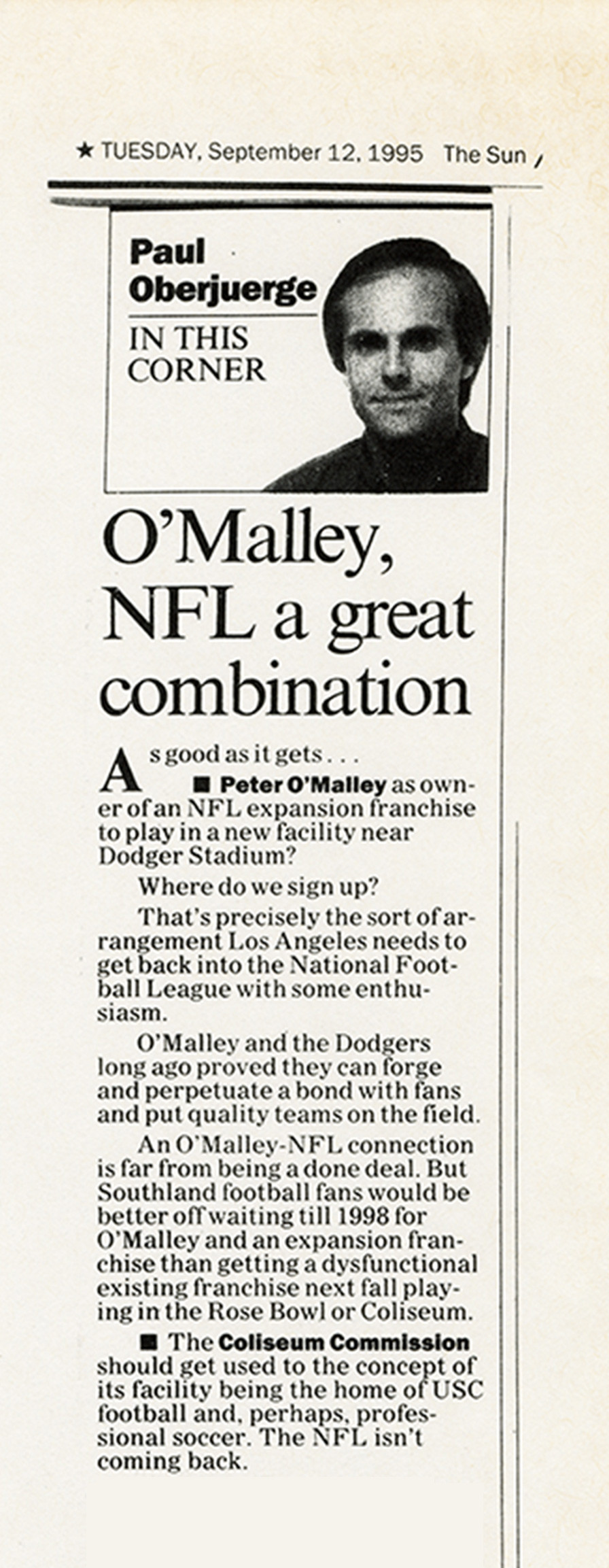
September 12, 1995, column by Paul Oberjuerge in the San Bernardino Sun about Peter O’Malley’s enthusiasm to build a new stadium near Dodger Stadium and owning an NFL franchise. In Oberjuerge’s opinion, “O’Malley and the Dodgers long ago proved they can forge and perpetuate a bond with fans and put quality teams on the field.”
O’Malley recalled in 2021 the process after Riordan’s initial August 22, 1995 call: “The next day I took Bob Graziano, Dodger chief financial officer, with me and the Mayor’s message was the same. I told him I would like to start seriously thinking about it. In the months following, I talked with community leaders, elected officials, NFL Commissioner Paul Tagliabue, President and Chief Operating Officer Neil Austrian, NFL Senior VP for League and Football Development Roger Goodell. I think it is fair to say that the more and more I met with the NFL executives and owners we bonded very well. The trust factor was established and there is no doubt in my mind that in those days our site was their most desirable one.” Houston Mitchell, Dodgers Dugout newsletter, Los Angeles Times, May 24, 2021
During his pursuit, O’Malley and Jerry Richardson, owner of the Carolina Panthers and Chairman of the NFL’s Stadium Committee, became good friends. “We trusted each other,” said O’Malley, “and that was the foundation of the relationship.”
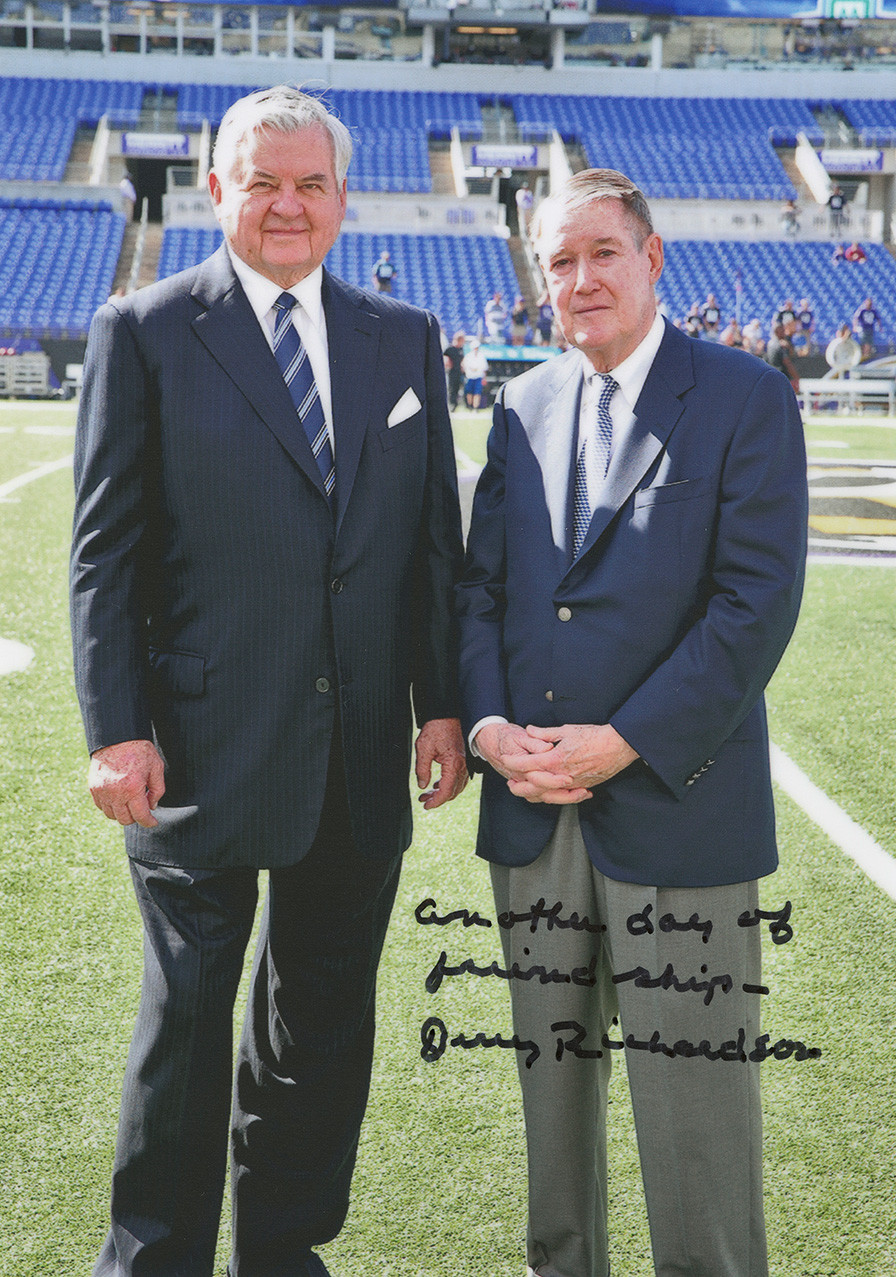
September 28, 2014, Carolina Panthers vs. Baltimore Ravens game, M&T Bank Stadium, Baltimore. Jerry Richardson, owner of the Panthers (left) with Peter O’Malley. Richardson served on the NFL’s powerful Stadium Committee and Management Council Executive Committee. When O’Malley worked with the NFL from 1995-1997, he frequently met with Richardson.
On January 29, 1996, the Los Angeles Downtown News reported, “L.A.’s newest powerhouse entertainment alliance is between Los Angeles Dodger owner Peter O’Malley and the high-profile firm of Catellus Development Corp. The two key firms believe their combined talents can land a National Football League team in Los Angeles. Last week the O’Malley/Catellus partnership emerged with a commitment to complete a feasibility study within the next six months to determine location, cost and financing options for a state-of-the-art football facility on 300 acres of Dodger property adjacent to Dodger Stadium.” Toni Birdsong, Los Angeles Downtown News, January 29, 1996
Catellus Development Corp. was led by CEO Nelson Rising who teamed with the Dodgers to work on all aspects of a feasibility study.
As a reminder to everyone in the Dodger organization that he was ensconced in the process of returning football to Los Angeles with a privately built new stadium, O’Malley designed and distributed ceramic mugs to Dodger front office employees with a football replacing a baseball in the Dodger logo.
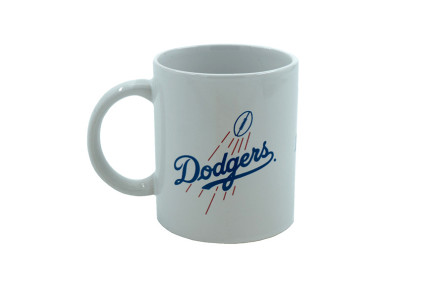
During the feasibility study process to potentially privately build a “world class” football stadium adjacent to Dodger Stadium, Dodger President Peter O’Malley ordered ceramic coffee mugs for all employees as a reminder that he was in pursuit of that goal. This side of the mug has the Dodgers script logo with a football.
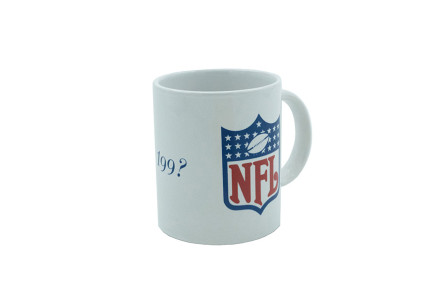
Dodger President Peter O’Malley presented coffee mugs to all Dodger employees as a reminder that he was working on pursuing privately building a state-of-the-art stadium for an NFL team to return to Los Angeles. On this side of the mug is the year “199?” and the NFL logo.
In May, 1996, O’Malley said, “We’re in the fifth inning now, but we expect to be in the ninth inning in mid-June. From the very first day when we were asked by the mayor if we were interested in building a state-of-the-art football facility, we have felt this could be the right thing. We won’t know all the results of our (feasibility) study until June, but I wouldn’t be on this path if I didn’t feel optimistic that the path we’re on does indeed make sense and is the best solution to the problem of football in Los Angeles. The stadium comes first, a football team comes second. The NFL has said that. The first bridge to cross is the stadium.” Rich Rupprecht, Santa Rosa Press Democrat, May 12, 1996
O’Malley said of the first contact from Mayor Riordan on August 22, 1995: “From the time and date of that initial phone call until this past August (1996), was an exciting and extraordinary time in my life.” T.J. Simers, Los Angeles Times, May 12, 1997 According to T.J. Simers, writing in the L.A. Times, “For months O’Malley had spent as much as 80% of his working days on football…A new football stadium appealed to him initially because he believed it would force people to look more closely at Dodger Stadium and conclude that it was time to rebuild utilizing modern specifications. A new Dodger Stadium would have increased revenues and let the family continue to compete successfully in the high-priced baseball market.” O’Malley said, “It was no. 1 on my agenda and we were getting positive results.” Ibid.
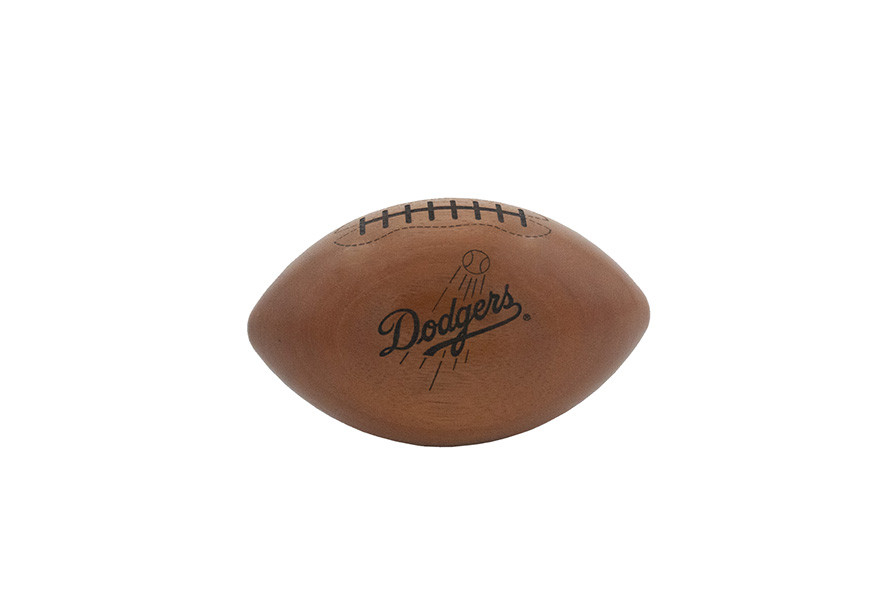
A small wooden football was created for Dodger President Peter O’Malley during a 1995-1996 feasibility study to determine if privately building a state-of-the-art football stadium adjacent to Dodger Stadium was viable. The study showed that it absolutely was achievable.
Simers continued, “O’Malley had notified (Mayor) Riordan on August 20 (1996) that ‘it was technically feasible’ to build a stadium on Dodger property. ‘In order for the city to be successful in returning professional football, civic and business leadership, the community and the fans must unite behind one solution,’ (a letter written by O’Malley to Mayor Riordan). But a few days later, while reading a newspaper, he (O’Malley) noticed a remark from one of the mayor’s advisors. The mayor and apparently everyone else in the city administration were united behind one solution: the Coliseum. Two weeks later he received official notification from John Molloy, administrator for the Community Redevelopment agency, writing for Riordan and other city officials. It asked O’Malley to throw his support behind the Coliseum. No explanation was given and none was sought, O’Malley said. When asked suddenly by a citywide contingent of political policymakers to stop his work, he obliged, promptly writing a letter pledging his support of the Coliseum. Always the diplomat, he (O’Malley) would not fight (City Hall).” O’Malley said, “We were extremely disappointed, but I completely understood the position we were asked to take.
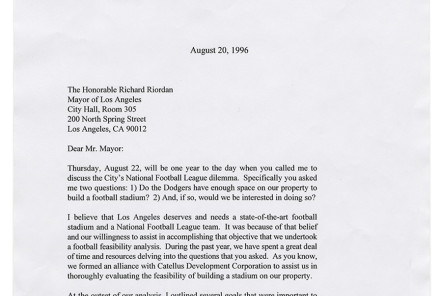
August 20, 1996, two days from the first anniversary of Los Angeles Mayor Richard Riordan’s initial call to Peter O’Malley, first page of a letter from O’Malley to Mayor Riordan of O’Malley’s belief a “world class” football stadium can be built on Dodger Stadium property to attract an NFL team to play in Los Angeles.
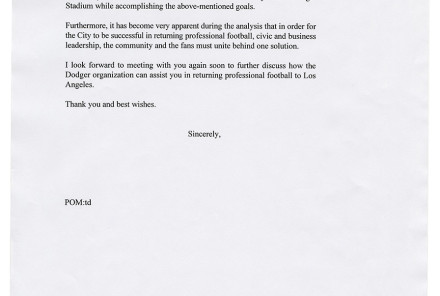
August 20, 1996, second page of letter from Peter O’Malley to Los Angeles Mayor Richard Riordan of O’Malley’s belief a “world class” football stadium can be privately built next to Dodger Stadium for the purpose of attracting an NFL team to play in Los Angeles.
“When we first started, we agreed we were going to spend up to $1 million (on the feasibility study)…but we paid about $1.5 million. Anyone who wants to say our look at football was a whim and not serious, I want to challenge that person to tell me that here…When we looked at football I had no intention of selling the ballclub-zero. We never (finished) the feasibility study because when we were about in the eighth inning that’s when we were asked to step aside. The feasibility study, in my opinion, would have concluded that it was technically feasible to build the most magnificent football stadium here on our property.” Ibid.
O’Malley was unexpectedly asked to step aside and join forces with efforts to renovate the Los Angeles Memorial Coliseum, spearheaded by Riordan and City Councilman Mark Ridley-Thomas. NFL Senior Vice President for League and Football Development and future NFL Commissioner Roger Goodell told the Los Angeles Times, “Peter O’Malley’s views on our plans for Los Angeles will be very important. He knows how to serve the fans of Los Angeles and deliver a first-class sports-entertainment attraction.” Jodi Wilgoren, Los Angeles Times, September 13, 1996
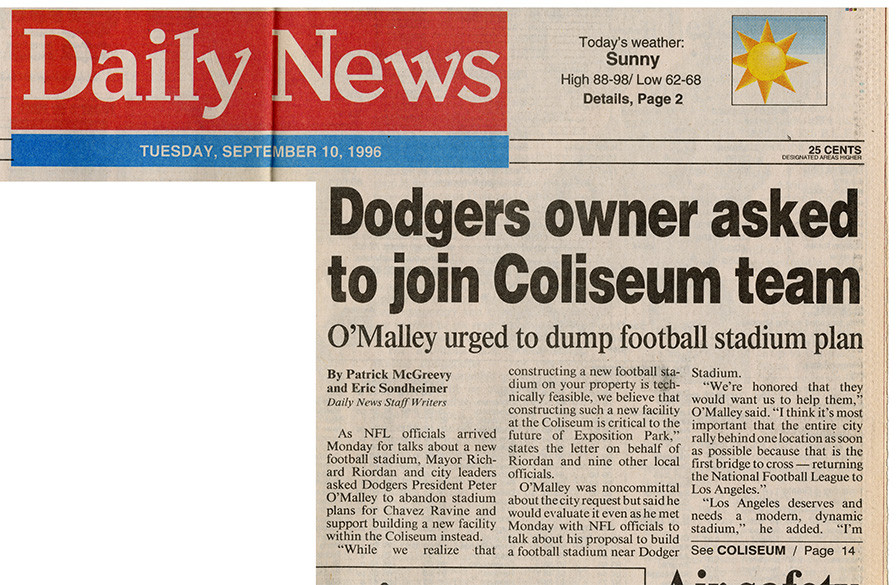
This September 10, 1996 article in the Los Angeles Daily News explains that Los Angeles Mayor Richard Riordan and city leaders abruptly asked O’Malley to abandon his plans to privately build a new football stadium adjacent to Dodger Stadium and to support the Los Angeles Memorial Coliseum for bringing football back. For two decades (1995-2015), Los Angeles was without an NFL team.
O’Malley said in a 2014 interview, “At first I thought it (the football stadium) should go northwest side of the property. The experts said ‘no, it should go on the south side of the property’. And that’s how we proceeded. And then he (Mayor Riordan) and other elected officials asked me to put our project back in the closet or else the Coliseum would never get a fair chance. I said, ‘Dick, the NFL is not going to the Coliseum. In the L.A. market they want it to be a cornerstone, flagship for the NFL. They want a brand new, state-of-the-art, best stadium possible. And that definition does not equate to the L.A. Coliseum.’ So we agreed, and put our plans in the closet. L.A. took a look at the Coliseum, the NFL did, and it was a non-starter, and then they said, ‘OK Peter come on back and look at it again.’ The football opportunity was the highest, best, compatible use for the stadium property. We had wide support – the media, the fans, everybody. But, politically, it was not meant to be.” Interview with Dan Temel, Cornell University student for senior thesis, March 18, 2014
“We engaged consultants in all fields from architecture to traffic to parking to environment and even acousticians,” O’Malley said in 2021. “We were making solid progress, but sadly some elected officials had other alternatives in mind. Our family invested more than $1 million in analyzing the concept to build a football stadium on our property. I was urged to carry on by the NFL and other interested parties, but when it was clear that the city representatives wanted us to shelve our plans I announced on October 18, 1997 with the headline in the Los Angeles Times that day “O’Malley backs off on NFL, Dodger owner says he will give Coliseum a little more time.” Again I was urged to put aside the city’s new view of the Coliseum when I concluded saying, ‘there comes a time when you can’t fight City Hall.’ I strongly believe that the NFL had no interest in renovating the Coliseum but that fell on deaf ears.” Houston Mitchell, Dodgers Dugout newsletter, Los Angeles Times, May 24, 2021
On September 18, 1996, Los Angeles Times columnist Mike Downey wrote, “By emotionally blackmailing Peter O’Malley, R.D. Hubbard (Hollywood park owner) and those would like to build a football stadium someplace else, Los Angeles politicians have harmed—not helped—the chances of this city landing a National Football League team in the near future by forcing the (L.A. Memorial) Coliseum down the NFL’s throat.” He continued, “No doubt understanding that he would be painted as an avaricious villain, should he continue to pursue a stadium of his own, O’Malley was left little choice but to sing the chorus of ‘unity’ and act the part of good burgher, even though the NFL would much rather be in business with him. Even though his own plan (to build a football facility), like his father’s was born of a desire not only for profit but progress. O’Malley, Hubbard, and others acted as independent businessman, and were made to feel like traitors…As a consequence, your choice is to have pro football at the Coliseum or no pro football at all. Some of us who love living in L.A. would also love a third option.” Mike Downey, Los Angeles Times, September 18, 1996
It was on January 6, 1997 that O’Malley surprised the baseball world when he announced that the Dodgers were being put up for sale. Football made a large impact on that decision to sell the asset which had been part of the O’Malley family for 50 years.
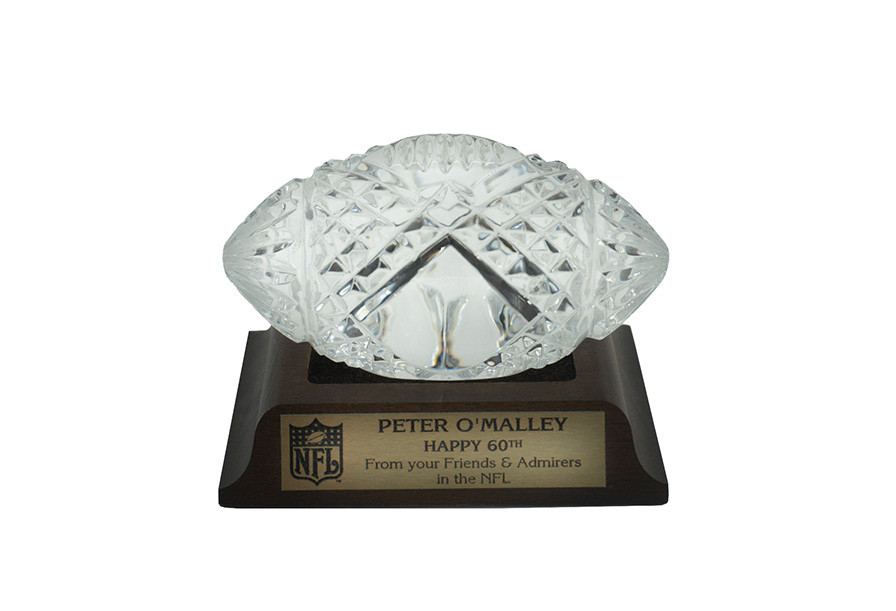
On the occasion of his 60th birthday in December, 1997, Peter O’Malley received this crystal football with wooden base from Roger Goodell and many other friends at the NFL. O’Malley and Goodell, NFL Senior VP for League and Football Development, were in close contact during 1995-1997 as O’Malley sought to privately build a football stadium in Los Angeles with the goal of the return of the NFL.
“Today, we would be about to be playing football in Los Angeles in a new, extraordinary, finest-ever football stadium. It’s sad,” O’Malley told Bill Plaschke of the L.A. Times on October 7, 1999. “Football would have been a perfect fit for our baseball team. It would have been a way for me to diversify into an industry that was profitable, to cover the losses of a baseball team that was not profitable.” Bill Plaschke, Los Angeles Times, October 7, 1999 The NFL eventually chose Houston to be the site of an expansion team and Los Angeles was shut out of a NFL team until the Rams’ return in 2016, 21 years later.
According to ESPN.com’s Arkash Markazi, political issues that resulted in Staples Center (now Crypto.com Arena) in downtown Los Angeles getting support and facility development of the Los Angeles Memorial Coliseum at the expense of NFL football not coming to L.A., in turn, led to the sale of the Dodgers. In 2011, Markazi wrote, “Chavez Ravine was the perfect site (for an NFL team), O’Malley was the perfect owner, and the project, most importantly, had the backing of the city and the league, which was hoping to put a team back in Los Angeles by 1998 if everything went according to plan…A year later, after O’Malley had already spent $1 million on the project and accumulated partners and allies, (Los Angeles Mayor Richard) Riordan pulled the plug. It was simply a political decision. Staples Center was nowhere near a reality in 1996 and in order to win over certain politicians with ties to the Coliseum, most notably Councilmen Mark Ridley-Thomas and the late John Ferraro, Riordan promised to rally the city’s support behind the Coliseum as the only viable site for an NFL team in Los Angeles even though the league (NFL) had already said it wasn’t an option when the Raiders left.” Arkash Markazi, ESPN.com, January 25, 2011 Markazi quoted John Semcken, partner of Ed Roski, who was developing Staples Center that, “Mark (Councilman Ridley-Thomas) said during the negotiations, ‘We’re going to get this done, but you guys have to come down and help us out at the Coliseum when we’re done.’ They made it clear if we helped them, they would help us.” Ibid.
In a 1999 interview, O’Malley said, “You can’t fight City Hall…I’m telling you, you can’t do it. You go against them, then try to go to them seeking votes on variance and things like that as you try to build your stadium. They could hold you up forever. If their heart was in the Coliseum, there’s no way even Superman could try another site and be successful.” Bill Plaschke, Los Angeles Times, October 7, 1999
Upon reflection in 2002, O’Malley said, “We basically sold (the Dodgers) because of football. People think it’s because the rest of the family wasn’t interested in the Dodgers, but that was never an issue. We had a lot of exciting plans for the NFL here, and the elected officials talked us out of it. They were committed to the Coliseum, and in my mind that was never a real alternative.” Mark Whicker, Orange County Register, August 23, 2002
On September 8, 2003, Bob Keisser wrote in the Long Beach Press Telegram: “Former mayor Richard Riordan will be remembered as the man who ruined two franchises in one swoop — killing Peter O’Malley plans to build a football stadium next to Dodger Stadium in favor of a renovated Coliseum proposal and in, the process, leading O’Malley to sell the Dodgers. It was a double play of epic proportions.” Bob Keisser, Long Beach Press Telegram, September 8, 2003
CITY OF LOS ANGELES – PETER O’MALLEY – NFL TIMELINE
I. Aug. 22, 1995, 3:25 p.m., Los Angeles Mayor Richard Riordan calls and leaves a message for Peter O’Malley. O’Malley returns his call and Mayor Riordan asks him two questions: 1) Do you have room to accommodate a new football stadium for an NFL team? and 2) Do you have any interest in building a stadium on Dodger Stadium property? Within 48 hours, O’Malley meets with the Mayor at City Hall. On Aug. 25, O’Malley meets with longtime Los Angeles Council President John Ferraro, who represented District 4, and was re-elected nine times (1966-2001). Ferraro served as longtime President of the City Council from 1987-2001.
II. Sept. 9, 1995, L.A. Times reports that O’Malley is “willing to be the driving force behind the return of professional football in Los Angeles by building a new stadium on Dodger Stadium property and ‘possibly’ owning an expansion team.” The article explains that a new O’Malley-built facility could be achieved by 1998
III. Sept. 20, 1995, O’Malley meets with Mayor Riordan
IV. Sept. 22, 1995, O’Malley meets with NFL Commissioner Paul Tagliabue
V. Oct. 12, 1995, O’Malley meets with Roger Goodell, NFL Senior Vice President, League and Football Development and expansion coordinator
VI. Oct. 24, 1995, O’Malley meets with developer Nelson Rising, CEO, Catellus
VII. Oct. 27, 1995, O’Malley meets with City Councilmember Mike Hernandez at City Hall
VIII. Nov. 1, 1995, Orange County Register article “Disney vs. O’Malley: It’s a super matchup to bring back football”
IX. Nov. 9, 1995, O’Malley meets with Jerry Richardson, Carolina Panthers owner and chair of NFL expansion committee, at Dodger Stadium and then for dinner
X. Fall meetings continue with Nelson Rising, George Milstein (attorney, Latham & Watkins), Roger Goodell, Mayor Riordan point men Steve Soboroff and Fred Rosen, Bill Wardlow (chief advisor to Mayor Riordan), Councilmember Mike Hernandez, Councilmember Jackie Goldberg and Bill Robertson, Executive Secretary-Treasurer, AFL-CIO. Distribution of Dodger football mugs created and given to Dodger employees and VIPs in fall, 1995
XI. Regular meetings continue in 1996 with Rising; Lew Wasserman at Universal; consultant and urban planner Ira Yellin; Goodell; Richardson; USC President Steven Sample (at O’Malley’s office); HOK; Crain & Associates; Neil Austrian; Los Angeles Chamber of Commerce leaders; Los Angeles County Supervisors; Soboroff and Rosen; neighbors of the proposed stadium; Councilmembers, including Mark Ridley-Thomas on Aug. 26, 1996
XII. March 8-9, 1996, O’Malley meets with NFL owner Jerry Richardson at Dodgertown, Vero Beach, Florida and the next day attends a meeting about the Los Angeles football problem at The Breakers in Palm Beach, Florida with influential NFL owners Richardson, Dan Rooney and Wellington Mara
XIII. Sept. 9, 1996, O’Malley is asked by Mayor Riordan to set aside plans to build a football stadium and support the L.A. Memorial Coliseum team
XIV. Sept. 17, 1996, Los Angeles Daily News article “O’Malley drops NFL plans: Dodgers owner backs rebuilding Coliseum: Abandoning effort a difficult decision”
XV. March 12, 1997, L.A. Times article “Coliseum Concept Turns Stale: Unswayed by L.A. hospitality, NFL owners might look again at the O’Malley option”
XVI. Meetings continued with Goodell, Richardson, Ridley-Thomas, Yellin, Rising/Catellus, Soboroff, and Garth Brooks through October 1997 before ceasing. O’Malley met with country music star Brooks at his Dodger Stadium office
What might have been had city officials continued the path of working with Peter O’Malley instead of Los Angeles Mayor Richard Riordan asking O’Malley stop his plans and stand down to support efforts for renovating the Los Angeles Memorial Coliseum a year after asking for Peter’s help. That abruptly pulled the plug on O’Malley’s vision and well-intended efforts to privately build a football stadium overlooking downtown Los Angeles in the parking lot of Dodger Stadium, after he had invested $1.5 million on feasibility studies, architectural drawings, renderings, and Environmental Impact Research (EIR).
Compiled and edited by Robert Schweppe and Brent Shyer

